Truma Vario Caravan Gas Heater
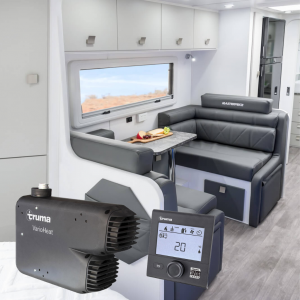
Even though most caravan air conditioner models also offer heating, unfortunately this is not always the most efficient means of heating, nor is it always enough for those of us who seem to feel the cold more than others and there is nothing worse than feeling cold and being unable to warn yourself up. We’ve heard many stories, from friends, family and strangers alike who have had to cut their visit short due simply because of the cold. Whether it is due to medical conditions such as joint pain or just simply how you are built (some of us feel the cold more than others), you are not the only one, and don’t let anyone tell you what you should or should not have in your van. It is your van and you want it to be comfortable. With COVID lockdowns and isolations, it has highlighted the importance of being prepared. Having a gas heater in your caravan may seem like over kill for some people, but we are all different.
Why You Would Choose a Truma Vario Gas Heater
If you are looking for a heating solution, look no further than the Truma VarioHeat. It is a caravan gas heater which gives you greater performance and control by allowing you to select your desired temperature which The Truma Vario will then automatically adjust itself in order to reach and then maintain your selected temperature. It is an efficient heating solution that is both lightweight at only 5.5kg and compact. Plus it has flexible installation options, being able to install it either vertically or horizontally in order to match your available space. The Truma Vario is easy to operate thanks to its CP Plus digital control which also you to not only select your temperature but also your output level and mode including boost and night mode.
Some reasons why you may want to get a gas heater installed in your van include:
- You plan on travelling to areas where the temperature frequently gets below 15 degrees
- You feel the cold and it affects your joints and health
- You want to be comfortable
- You can spend long periods of time in your caravan or motorhome
- You already have gas appliances in your van
Should you need some extra oomph to heat your caravan or motorhome, or you have a larger space you wish to heat, then there is the additional option to add the Truma E-Kit. The E-Kit provides you with an extra 1800w which then gives you even greater control over how you use your heater as you can choose to use, electric, gas or a combination of the two.
Truma Vario Features:
- 2 output levels
- Digital control panel
- Automatic heat regulation
- Lightweight and compact
- Even heat distribution
- High air output for fast heating
- Boost function
- Night mode: operates hater at its lowest level of 1300 watts
- Optional Extra: E-Kit provides an extra 1800w (2x900w heating coils) which can allow faster heating, use combination of electricity and gas or both.
Truma Vario Specifications:
Type of gas: Propane / Butane
Test point pressure 2.00 kPa
Operating pressure 2.75 kPa
Rated thermal input (gas consumption) Min. stage: 4.53 MJ/h (90 g/h)
ISA Max. stage: 9.75 MJ/h (193 g/h)
ISA Thermal efficiency Min. stage: 86 % Max. stage: 84 %
Air flow rate 85 m³/h – 175 m³/h
Duct static pressure < 170 Pa (1.7 mbar)
Heating power: 1300 W (Level 1) / 2800 W (Level 2) / 3700 W (Level 3)
Efficiency: 98% (Level 1) / 96% (Level 2) / 94% (Level 3)
Gas consumption: 100 g/h (Level 1) / 220 g/h (Level 2) / 290 g/h (Level 3)
Power consumption 12 V: 0.65 A (Level 1) / 2.75 A (Level 2) / 5.4 A (Level 3)
Temperature rise < 80 °C
Power supply 10.5 – 16 V
Power consumption at nominal Voltage 12 V Operating: 0.85 – 3.65 A
Stand-by: 0.004 A
Weight: 5.5 kg
Dimensions: 437 mm x 284mm x 123mm
Warranty: 2 years
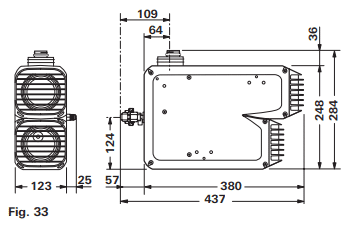
FAQ- Truma Vario Gas Heater
There is no clear or fast rule about whether a gas heater is better than a diesel heater. Before deciding on which type of heater to go ahead with, you need to consider your travel plans, your existing setup as to what you have room and access for, as well as your budget.
In terms of efficiency, gas and diesel can often be on par with each other. Both are efficient forms of heating. However, with the prices of diesel on the rise along with general fuel prices, diesel heaters are becoming more expensive to run.
This varies across models so it is important to check your product manual.
Some units such as the Suburban, use a sacrificial anode rod which needs to be replaced every 6-12 months (regardless of use), while other units such as the Truma AquaGo will use decalcification tablets. If your RV hot water system uses a holding tank such as the Swift hot water system, you will need to clean out your tank from time to time and when your van is not in use, drain the water out use to prevent any nasties building up in the tank. Other common maintenance includes checking and or replacing the element.
Like any appliance, servicing and installation by a qualified technician is recommended to extend the life of the unit and to ensure you do not void the warranty by damaging the unit or hurt yourself.
Each van is different and the location of installation will depend on available space. You need to consider inside the van, where you want the vents to be located for the most efficient heating. But you also need to consider the outside of your van, in terms of venting and running the gas lines to the unit. The most common location is under the bed. However, it can be located in a cupboard or under the dining area.
Pros
- Heats to required temperature very quickly.
- If you already have gas appliances in your caravan or motorhome, adding in a gas heater is relatively straight forward.
- A reliable and efficient form of heating that is also quiet.
- Considered to be quieter than diesel heaters (this can vary across makes and models though)
- Flexible installation means it can be installed vertically or horizontally
- Optional extra E-kit available for even more heating power (though it is a separate purchase).
Cons
- Though the TrumaVario will operate in low temperatures, it will not work if your gas bottle freezes. You will need to be mindful of how you store your gas bottles when travelling to destinations that see temperatures drop below 2 degrees.
- You can not try to save a few bucks by installing yourself. The Truma Vario does need to be fitted and certified by a licenced gas fitter.
- Gas certificate required. It is not just upon installation. Any time work is done to your gas appliances- updating, removing or adding as well as selling your van, you will need to get a new gas certificate which adds in an additional cost.
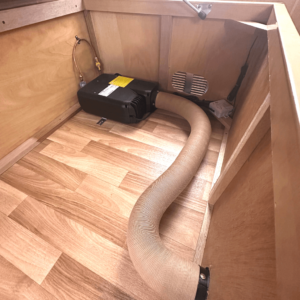
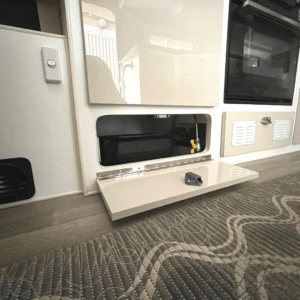
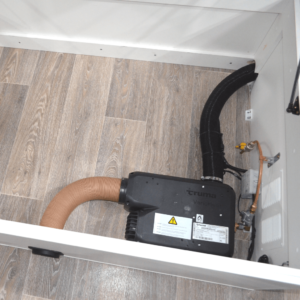
Product Manual:
If you’ve lost your booklet or you’ve bought a second hand van and one wasn’t included, no worries. We have the Truma VarioHeat gas heater operating manual available, simply download below. The operating manual is a useful reference tool for correct operation of your unit, as well as maintenance and troubleshooting guide to ensure you get the best life and use out of your Truma VarioHeat Gas Heater.
Should you require additional information about whether the Truma VarioHeat is suitable for your setup, please get in contact with us. Should you require additional information regarding the unit itself, please contact Leisure-Tec.
